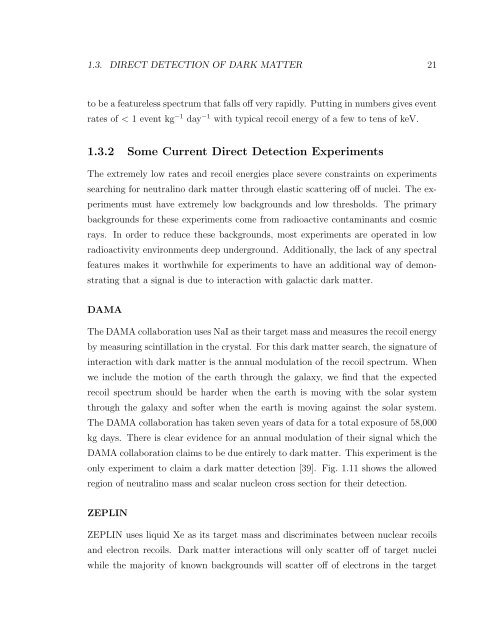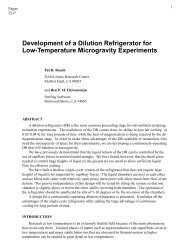cdms-ii - CDMS Experiment - University of California, Berkeley
cdms-ii - CDMS Experiment - University of California, Berkeley
cdms-ii - CDMS Experiment - University of California, Berkeley
Create successful ePaper yourself
Turn your PDF publications into a flip-book with our unique Google optimized e-Paper software.
1.3. DIRECT DETECTION OF DARK MATTER 21<br />
to be a featureless spectrum that falls <strong>of</strong>f very rapidly. Putting in numbers gives event<br />
rates <strong>of</strong> < 1 event kg −1 day −1 with typical recoil energy <strong>of</strong> a few to tens <strong>of</strong> keV.<br />
1.3.2 Some Current Direct Detection <strong>Experiment</strong>s<br />
The extremely low rates and recoil energies place severe constraints on experiments<br />
searching for neutralino dark matter through elastic scattering <strong>of</strong>f <strong>of</strong> nuclei. The experiments<br />
must have extremely low backgrounds and low thresholds. The primary<br />
backgrounds for these experiments come from radioactive contaminants and cosmic<br />
rays. In order to reduce these backgrounds, most experiments are operated in low<br />
radioactivity environments deep underground. Additionally, the lack <strong>of</strong> any spectral<br />
features makes it worthwhile for experiments to have an additional way <strong>of</strong> demonstrating<br />
that a signal is due to interaction with galactic dark matter.<br />
DAMA<br />
The DAMA collaboration uses NaI as their target mass and measures the recoil energy<br />
by measuring scintillation in the crystal. For this dark matter search, the signature <strong>of</strong><br />
interaction with dark matter is the annual modulation <strong>of</strong> the recoil spectrum. When<br />
we include the motion <strong>of</strong> the earth through the galaxy, we find that the expected<br />
recoil spectrum should be harder when the earth is moving with the solar system<br />
through the galaxy and s<strong>of</strong>ter when the earth is moving against the solar system.<br />
The DAMA collaboration has taken seven years <strong>of</strong> data for a total exposure <strong>of</strong> 58,000<br />
kg days. There is clear evidence for an annual modulation <strong>of</strong> their signal which the<br />
DAMA collaboration claims to be due entirely to dark matter. This experiment is the<br />
only experiment to claim a dark matter detection [39]. Fig. 1.11 shows the allowed<br />
region <strong>of</strong> neutralino mass and scalar nucleon cross section for their detection.<br />
ZEPLIN<br />
ZEPLIN uses liquid Xe as its target mass and discriminates between nuclear recoils<br />
and electron recoils. Dark matter interactions will only scatter <strong>of</strong>f <strong>of</strong> target nuclei<br />
while the majority <strong>of</strong> known backgrounds will scatter <strong>of</strong>f <strong>of</strong> electrons in the target




